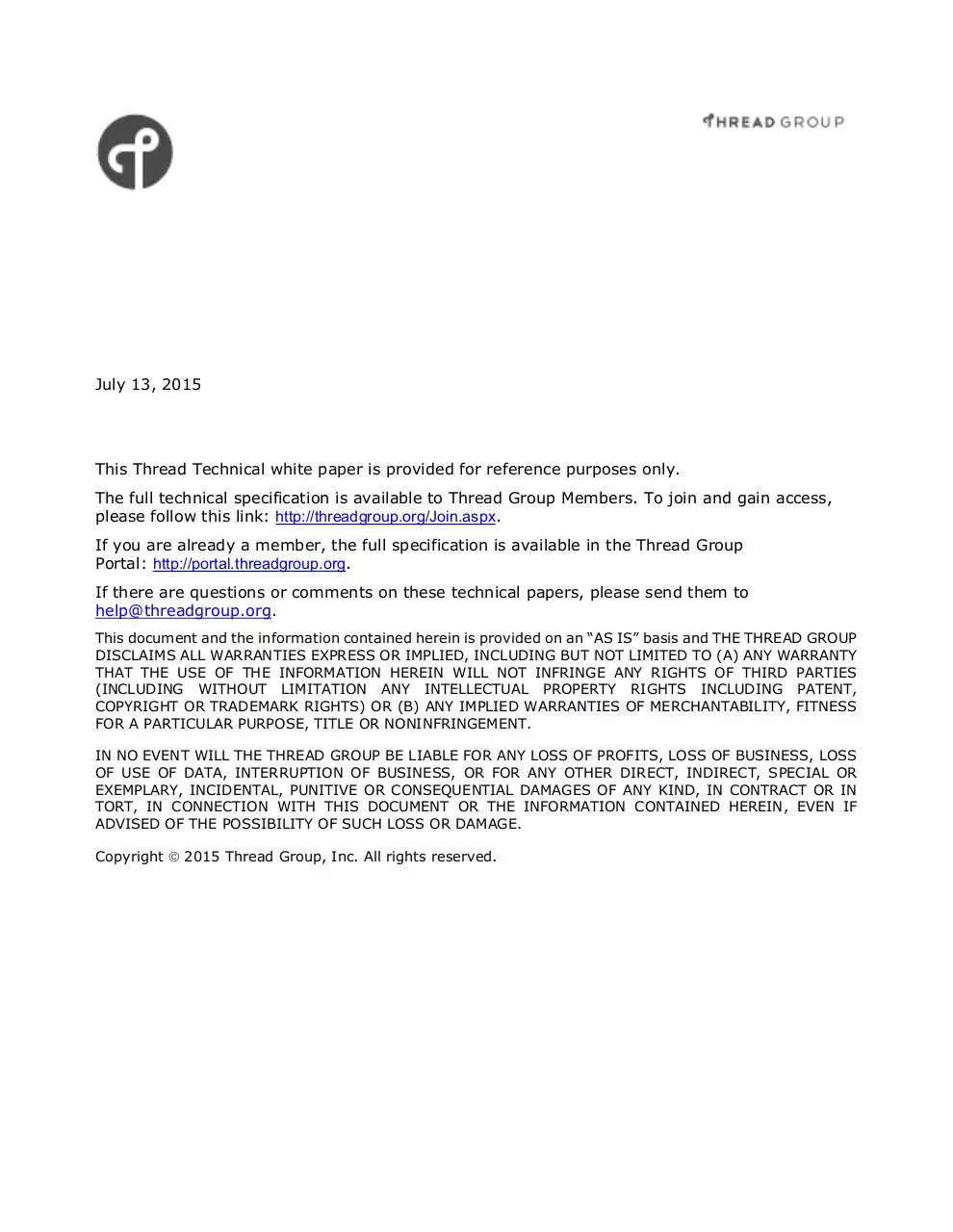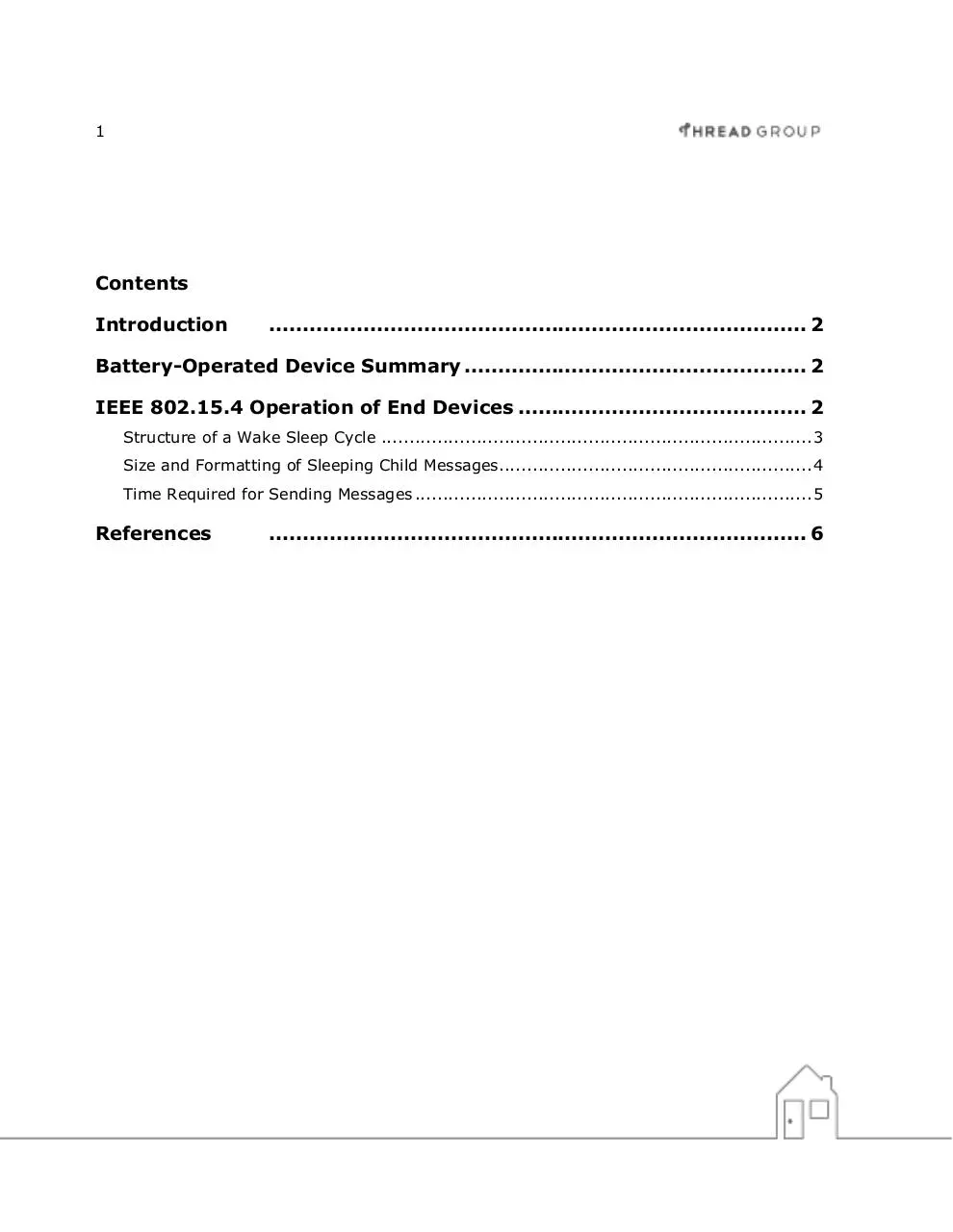Thread Battery Operated Devices white paper v1 public (PDF)
File information
Title: Battery-Operated Devices white paper
Author: Thread Group, Inc.
This PDF 1.6 document has been generated by Acrobat PDFMaker 11 for Word / Adobe PDF Library 11.0, and has been sent on pdf-archive.com on 18/11/2015 at 15:21, from IP address 217.153.x.x.
The current document download page has been viewed 493 times.
File size: 207.58 KB (8 pages).
Privacy: public file





File preview
July 13, 2015
This Thread Technical white paper is provided for reference purposes only.
The full technical specification is available to Thread Group Members. To join and gain access,
please follow this link: http://threadgroup.org/Join.aspx.
If you are already a member, the full specification is available in the Thread Group
Portal: http://portal.threadgroup.org.
If there are questions or comments on these technical papers, please send them to
help@threadgroup.org.
This document and the information contained herein is provided on an “AS IS” basis and THE THREAD GROUP
DISCLAIMS ALL WARRANTIES EXPRESS OR IMPLIED, INCLUDING BUT NOT LIMITED TO (A) ANY WARRANTY
THAT THE USE OF THE INFORMATION HEREIN WILL NOT INFRINGE ANY RIGHTS OF THIRD PARTIES
(INCLUDING WITHOUT LIMITATION ANY INTELLECTUAL PROPERTY RIGHTS INCLUDING PATENT,
COPYRIGHT OR TRADEMARK RIGHTS) OR (B) ANY IMPLIED WARRANTIES OF MERCHANTABILITY, FITNESS
FOR A PARTICULAR PURPOSE, TITLE OR NONINFRINGEMENT.
IN NO EVENT WILL THE THREAD GROUP BE LIABLE FOR ANY LOSS OF PROFITS, LOSS OF BUSINESS, LOSS
OF USE OF DATA, INTERRUPTION OF BUSINESS, OR FOR ANY OTHER DIRECT, INDIRECT, SPECIAL OR
EXEMPLARY, INCIDENTAL, PUNITIVE OR CONSEQUENTIAL DAMAGES OF ANY KIND, IN CONTRACT OR IN
TORT, IN CONNECTION WITH THIS DOCUMENT OR THE INFORMATION CONTAINED HEREIN, EVEN IF
ADVISED OF THE POSSIBILITY OF SUCH LOSS OR DAMAGE.
Copyright 2015 Thread Group, Inc. All rights reserved.
Battery-Operated Devices
July 2015
Revision History
Revision
Date
Comments
1.0
July 13, 2015
Public Release
1
Contents
Introduction
................................................................................ 2
Battery-Operated Device Summary ................................................... 2
IEEE 802.15.4 Operation of End Devices ........................................... 2
Structure of a Wake Sleep Cycle ............................................................................. 3
Size and Formatting of Sleeping Child Messages........................................................ 4
Time Required for Sending Messages ....................................................................... 5
References
................................................................................ 6
2
Introduction
The goal of the Thread Group is to design, deploy, and promote an open standard for reliable,
cost-effective, low-power, wireless D2D (device-to-device) communication within the home. (For
a full and complete overview, refer to the “Thread Stack Fundamentals” white paper.) The lowpower part of this goal is delivered by operation of battery-powered devices. The Thread Network
is built with always on (powered) Routers and battery-operated devices use these Routers as their
Parent and to hold and route messages.
This white paper explains the basic operation of these battery-operated devices and compares
their performance.
Battery-Operated Device Summary
Battery-operated devices either wake and poll their Parent for any messages, or wake and send
data. The efficiency of these operations determines the energy usage and ultimately the battery
life of these devices. It is critical to optimize these basic operations to ensure suitable battery
life for devices.
IEEE 802.15.4 Operation of End Devices
Battery-operated devices have two basic behaviors: waking to send data or waking to retrieve
data that has been sent to them. Because data cannot be sent directly to a sleepy device, the
Parent of that device holds the data for a finite time and the sleeping device can request it
(Figure 1).
Figure 1. Router Acting as a Parent for Child End Device
For the battery-operated device to wake and send data, it simply wakes up, forms a packet with
the appropriate data, and sends it to its Parent which is then responsible for forwarding it
through the Thread Network to the destination. A simple case of this is when a window sensor is
activated and this interrupt wakes the processor to send a message indicating the window is
now open.
3
The IEEE 802.15.4-2006 standard [IEEE802154] prescribes how battery-operated devices can
request data from their Parent. Specifically Section 5.3.4 details a Data Request MAC Command
frame that is used to poll a Parent to see if it has data. The Parent responds with an
acknowledgement frame with the frame pending bit set to ‘1’ if there is data for the device and
‘0’ if there is no data for the device. A simple case of this data flow is if a user wants to change
the configuration of a sleeping door sensor to wake more frequently to report status and battery
life. This message is routed to the Parent of the sleeping device and held there for the sleeping
device to wake and poll for the message.
Structure of a Wake Sleep Cycle
Figure 2 illustrates a normal wake sleep cycle.
Figure 2. Typical Wake Sleep Cycle
4
The radio and MCU (Microcontroller) go through the following steps:
1. Wake from deep sleep.
2. Complete code and crystal startup sequence.
3. Radio initialization.
4. Enter receive mode and check for clear air.
5. Switch to transmit.
6. Transmit packet.
7. Wait for and receive acknowledgement.
8. Return to deep sleep.
There are a number of variables that impact the actual power consumption during this wake
sleep cycle. Some important factors are:
•
Time for the device to wake from deep sleep and be ready with the radio
(implementation-specific).
•
Time on the air transmitting (size of the packet).
•
Time waiting for the ACK packet (defined in the 802.15.4 specification)
•
Active currents during the various operations (implementation-specific).
An implementer can optimize some of the times and the radio and MCU design impact the timing
and current consumption. The time on the air and time waiting for the ACK is set by the packet
size and 802.15.4 specification timing and do not vary between implementations.
Size and Formatting of Sleeping Child Messages
There are two packet formats that impact the time on-the-air and therefore battery life of
sleeping devices: the Data Poll MAC Command Frame and the normal Data Frame used for
sending messages.
Figure 3 illustrates the IEEE 802.15.4 MAC Command Frame used for the data poll.
Figure 3. IEEE 802.15.4 MAC Command Frame
5
In Thread the Addressing fields include a 2 byte PANID, the 2byte Short Destination Address and
the 2 byte long Source Address. There is no command payload. Thread also secures these data
polls so there is a 6-byte security header and a 4-byte MIC (Message Integrity Code). This
means the data poll command is 22 bytes long.
Figure 4 illustrates the overall structure of a complete Thread data packet.
Figure 4. Complete Thread Data Packet
This packet results in an overhead of 35 bytes without application security and 64 bytes if DTLS
(Datagram Transport Layer Security) security is added to the application (note this is optional).
These packet formats determine the transmit time for a radio sending the data.
Time Required for Sending Messages
The discussion above details the basis for battery operated device behavior. However, actual
measurements are required to validate how long a radio and software implementation takes to
perform these operations.
Table 1 shows the time in milliseconds for Thread transactions from a battery-operated end device.
6
Table 1. Thread Wake Sleep Transaction Time
Event
Minimum Time
(milliseconds)
Maximum Time
(milliseconds)
Poll No Data
4.03
6.31
Send 10 bytes
4.41
8.2
Send 50 bytes
8.38
9.94
12.78
16.78
Send 100 bytes
Notes
22-byte packet, with
security
97 byte packet with MAC
security
All packets are using MAC security, including the data poll.
The difference between the minimum time and the maximum is the variation in the clear
channel assessment timing.
The actual current consumption during these operations depend on the radio and MCU used and
its active current profile.
For example on the Poll No Data the energy used averages 100 μCoulombs. This means a device
with a CR2032 battery waking every 10 seconds would last approximately 2.6 years.
References
Document
Title
[IEEE802154]
Wireless Personal Area Networks
Download Thread Battery-Operated Devices white paper v1 public
Thread Battery-Operated Devices white paper_v1_public.pdf (PDF, 207.58 KB)
Download PDF
Share this file on social networks
Link to this page
Permanent link
Use the permanent link to the download page to share your document on Facebook, Twitter, LinkedIn, or directly with a contact by e-Mail, Messenger, Whatsapp, Line..
Short link
Use the short link to share your document on Twitter or by text message (SMS)
HTML Code
Copy the following HTML code to share your document on a Website or Blog
QR Code to this page

This file has been shared publicly by a user of PDF Archive.
Document ID: 0000315743.